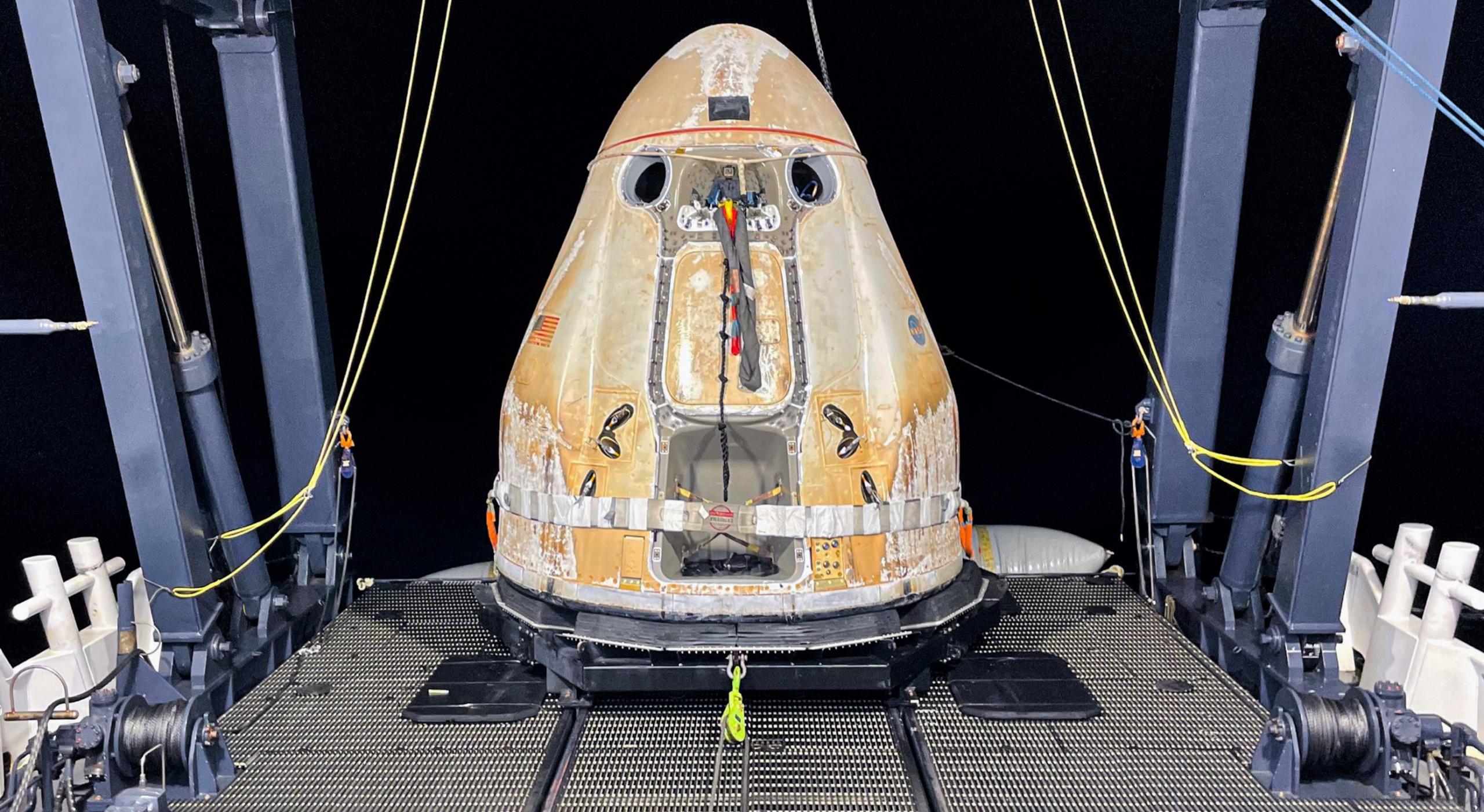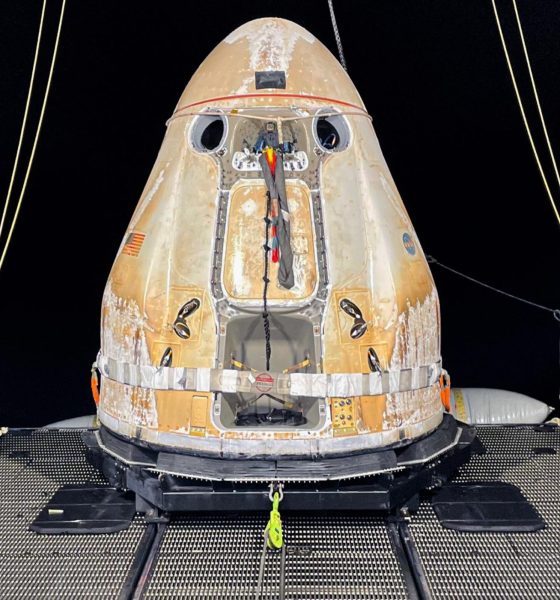

News
SpaceX Dragon spacecraft returns NASA cargo to Earth after six weeks in space
A SpaceX Cargo Dragon 2 spacecraft has safely returned to Earth after delivering several tons of NASA supplies to the International Space Station (ISS).
A little over six weeks after Falcon 9 launched SpaceX’s 26th Commercial Resupply Services 2 (CRS2) mission for NASA, Dragon departed the ISS on January 9th. Efficiently lowering its orbit with several small Draco thrusters took about 36 hours, and reusable Dragon 2 capsule C211 eventually slowed to the point that it began impacting Earth’s atmosphere. Using its ablative heat shield like a brake pad, Dragon slowed from a velocity of 7.5 kilometers per second (16,800 mph) to about 155 meters per second (~350 mph) before beginning parachute deployment.
At 5:19 am on January 11th, the Dragon capsule gently splashed down off the coast of Tampa, Florida, and was quickly secured by a SpaceX recovery ship. Once onboard, the capsule was opened up, and cargo fresh from orbit was loaded onto a helicopter as quickly as possible. That system – primarily created to rapidly transport astronauts back to NASA medical facilities – also means that scientists can get access to their recovered ISS experiments just a handful of hours after Cargo Dragon splashes down.
The update that's rolling out to the fleet makes full use of the front and rear steering travel to minimize turning circle. In this case a reduction of 1.6 feet just over the air— Wes (@wmorrill3) April 16, 2024
Some of the scientific investigations returned by Dragon include:
Deep space radiation protection: A vest designed to protect astronauts from high doses of radiation caused by unpredictable solar particle events is returning to Earth after months of testing. Crew members wore the Astrorad vest while performing daily tasks and provided feedback about how easy it is to put on, how it fits and feels, and the range of motion possible while wearing it. The vest’s developers plan to use that feedback to improve design of the garment, which could provide radiation protection for astronauts on Artemis missions to the Moon.
Air, water, plants: XROOTS used hydroponic (water-based) and aeroponic (air-based) techniques to grow plants without soil or other growth media. Researchers collected video and still images to evaluate growth chambers through the plant life cycle from seed germination through maturity. The plant chambers are returning to Earth for additional analysis. Similar techniques could be used to produce crops for future space missions and to enhance cultivation and food security for the benefit of people on Earth.
Bioprospecting in space: Bioprospecting is the process of identifying plants and animals that may contain substances with potential for use as drugs, biochemicals, and more. Previous studies found that space can cause genetic and physiological changes that could result in microbes yielding such materials. Rhodium Microgravity Bioprospecting-1 studied a way to search for these microbes. The science chambers and temperature logger from the investigation are returning to Earth for further examination.”
Blogs.NASA.gov – January 11th, 2023
SpaceX’s second-generation Cargo Dragon spacecraft is nearly identical to Crew Dragon. Both are made up of two main parts: a reusable capsule and an expendable ‘trunk.’ The Dragon 2 trunk is a tube-like carbon fiber composite structure covered by a skin of curved solar arrays and radiators. It can also hold several tons of unpressurized cargo.
Dragon’s capsule holds a pressure vessel, environmental control systems (ECLSS), all 16 Draco maneuvering thrusters, propellant tanks, docking systems, and an ablative heat shield. In the case of Crew Dragon, the capsule is also outfitted with windows, crew seats, hand control, and SuperDraco launch abort thrusters. Both Cargo and Crew Dragon capsules represent the vast majority of the total spacecraft cost and can be recovered, refurbished, and reflown in as little as four months.
NASA is SpaceX’s only Cargo Dragon customer. January 11th’s recovery marked the completion of CRS2 Spx-26, SpaceX’s 25th successful ISS resupply mission since 2012. After adding more contracts last year, NASA has arrangements for at least nine more Dragon 2 resupply missions stretching into 2026 or 2027. NASA also signed contracts for eight Crew Dragon astronaut launches in 2022 and has nine missions on contract between now and the late 2020s or 2030.
While Falcon 9 infamously failed during the June 2015 launch of CRS-7, every Dragon that has ever reached orbit has been recovered in one piece. Spx-26 was Dragon’s 38th mission overall and 35th consecutively successful recovery from orbit.


Elon Musk
Elon Musk and Tesla AI Director share insights after empty driver seat Robotaxi rides
The executives’ unoccupied tests hint at the rapid progress of Tesla’s unsupervised Robotaxi efforts.

Tesla CEO Elon Musk and AI Director Ashok Elluswamy celebrated Christmas Eve by sharing personal experiences with Robotaxi vehicles that had no safety monitor or occupant in the driver’s seat. Musk described the system’s “perfect driving” around Austin, while Elluswamy posted video from the back seat, calling it “an amazing experience.”
The executives’ unoccupied tests hint at the rapid progress of Tesla’s unsupervised Robotaxi efforts.
Elon and Ashok’s firsthand Robotaxi insights
Prior to Musk and the Tesla AI Director’s posts, sightings of unmanned Teslas navigating public roads were widely shared on social media. One such vehicle was spotted in Austin, Texas, which Elon Musk acknowleged by stating that “Testing is underway with no occupants in the car.”
Based on his Christmas Eve post, Musk seemed to have tested an unmanned Tesla himself. “A Tesla with no safety monitor in the car and me sitting in the passenger seat took me all around Austin on Sunday with perfect driving,” Musk wrote in his post.
Elluswamy responded with a 2-minute video showing himself in the rear of an unmanned Tesla. The video featured the vehicle’s empty front seats, as well as its smooth handling through real-world traffic. He captioned his video with the words, “It’s an amazing experience!”
Towards Unsupervised operations
During an xAI Hackathon earlier this month, Elon Musk mentioned that Tesla owed be removing Safety Monitors from its Robotaxis in Austin in just three weeks. “Unsupervised is pretty much solved at this point. So there will be Tesla Robotaxis operating in Austin with no one in them. Not even anyone in the passenger seat in about three weeks,” he said. Musk echoed similar estimates at the 2025 Annual Shareholder Meeting and the Q3 2025 earnings call.
Considering the insights that were posted Musk and Elluswamy, it does appear that Tesla is working hard towards operating its Robotaxis with no safety monitors. This is quite impressive considering that the service was launched just earlier this year.
Elon Musk
Starlink passes 9 million active customers just weeks after hitting 8 million
The milestone highlights the accelerating growth of Starlink, which has now been adding over 20,000 new users per day.

SpaceX’s Starlink satellite internet service has continued its rapid global expansion, surpassing 9 million active customers just weeks after crossing the 8 million mark.
The milestone highlights the accelerating growth of Starlink, which has now been adding over 20,000 new users per day.
9 million customers
In a post on X, SpaceX stated that Starlink now serves over 9 million active users across 155 countries, territories, and markets. The company reached 8 million customers in early November, meaning it added roughly 1 million subscribers in under seven weeks, or about 21,275 new users on average per day.
“Starlink is connecting more than 9M active customers with high-speed internet across 155 countries, territories, and many other markets,” Starlink wrote in a post on its official X account. SpaceX President Gwynne Shotwell also celebrated the milestone on X. “A huge thank you to all of our customers and congrats to the Starlink team for such an incredible product,” she wrote.
That growth rate reflects both rising demand for broadband in underserved regions and Starlink’s expanding satellite constellation, which now includes more than 9,000 low-Earth-orbit satellites designed to deliver high-speed, low-latency internet worldwide.
Starlink’s momentum
Starlink’s momentum has been building up. SpaceX reported 4.6 million Starlink customers in December 2024, followed by 7 million by August 2025, and 8 million customers in November. Independent data also suggests Starlink usage is rising sharply, with Cloudflare reporting that global web traffic from Starlink users more than doubled in 2025, as noted in an Insider report.
Starlink’s momentum is increasingly tied to SpaceX’s broader financial outlook. Elon Musk has said the satellite network is “by far” the company’s largest revenue driver, and reports suggest SpaceX may be positioning itself for an initial public offering as soon as next year, with valuations estimated as high as $1.5 trillion. Musk has also suggested in the past that Starlink could have its own IPO in the future.
News
NVIDIA Director of Robotics: Tesla FSD v14 is the first AI to pass the “Physical Turing Test”
After testing FSD v14, Fan stated that his experience with FSD felt magical at first, but it soon started to feel like a routine.

NVIDIA Director of Robotics Jim Fan has praised Tesla’s Full Self-Driving (Supervised) v14 as the first AI to pass what he described as a “Physical Turing Test.”
After testing FSD v14, Fan stated that his experience with FSD felt magical at first, but it soon started to feel like a routine. And just like smartphones today, removing it now would “actively hurt.”
Jim Fan’s hands-on FSD v14 impressions
Fan, a leading researcher in embodied AI who is currently solving Physical AI at NVIDIA and spearheading the company’s Project GR00T initiative, noted that he actually was late to the Tesla game. He was, however, one of the first to try out FSD v14.
“I was very late to own a Tesla but among the earliest to try out FSD v14. It’s perhaps the first time I experience an AI that passes the Physical Turing Test: after a long day at work, you press a button, lay back, and couldn’t tell if a neural net or a human drove you home,” Fan wrote in a post on X.
Fan added: “Despite knowing exactly how robot learning works, I still find it magical watching the steering wheel turn by itself. First it feels surreal, next it becomes routine. Then, like the smartphone, taking it away actively hurts. This is how humanity gets rewired and glued to god-like technologies.”
The Physical Turing Test
The original Turing Test was conceived by Alan Turing in 1950, and it was aimed at determining if a machine could exhibit behavior that is equivalent to or indistinguishable from a human. By focusing on text-based conversations, the original Turing Test set a high bar for natural language processing and machine learning.
This test has been passed by today’s large language models. However, the capability to converse in a humanlike manner is a completely different challenge from performing real-world problem-solving or physical interactions. Thus, Fan introduced the Physical Turing Test, which challenges AI systems to demonstrate intelligence through physical actions.
Based on Fan’s comments, Tesla has demonstrated these intelligent physical actions with FSD v14. Elon Musk agreed with the NVIDIA executive, stating in a post on X that with FSD v14, “you can sense the sentience maturing.” Musk also praised Tesla AI, calling it the best “real-world AI” today.








